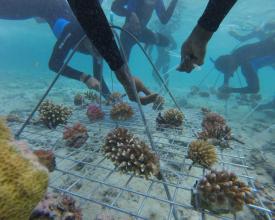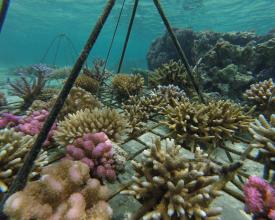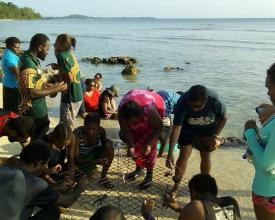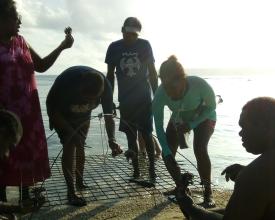
Le jardinage du corail pour l'adaptation au changement climatique à Vanuatu
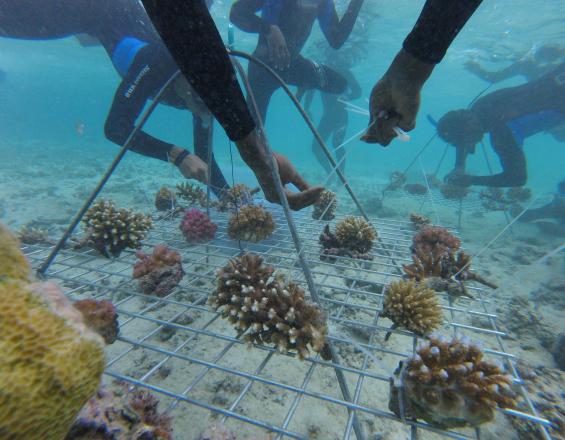
La CPS/GIZ, en partenariat avec le réseau de zones protégées marines et terrestres Nguna-Pele de Vanuatu, met en œuvre un projet d'adaptation au changement climatique des récifs coralliens axé sur le jardinage des coraux. Les récifs coralliens endommagés sont restaurés, contribuant ainsi à l'adaptation au changement climatique et aux revenus de l'écotourisme. Les visiteurs étrangers sont invités à participer à cette activité de plantation, ce qui leur permet de contribuer à un problème de développement local.
Contexte
Défis à relever
Le Vanuatu est particulièrement vulnérable aux effets néfastes du changement climatique. Les habitants de nombreuses îles souffrent déjà de l'élévation du niveau de la mer et des phénomènes météorologiques extrêmes tels que les ouragans, les sécheresses, les fortes pluies et les inondations, ainsi que de leurs effets, par exemple l'inondation des côtes, la perte de nutriments du sol et l'érosion des côtes et des collines. L'élévation prévue du niveau de la mer, la modification du régime des précipitations, la hausse des températures et l'acidification des océans exacerberont ces risques au cours des prochaines décennies. Cela met en péril les moyens de subsistance des populations, dont la plupart sont engagées dans l'agriculture, la sylviculture et la pêche et dépendent donc des ressources naturelles. Les phénomènes météorologiques extrêmes ont également un impact particulièrement néfaste sur le tourisme.
Les récifs coralliens sont actuellement menacés par le changement climatique (acidification des océans, augmentation de la température des océans), les espèces invasives (étoile de mer Crown of Thorns) et les activités humaines. Cela affecte leur rôle dans la protection des côtes et de l'écosystème insulaire.
Emplacement
Traiter
Résumé du processus
Le changement climatique exige des solutions globales. Nous avons constaté que dans les petites communautés insulaires, les liens entre les récifs coralliens, les moyens de subsistance, la génération de revenus et le changement climatique sont intrinsèquement liés. Pour cette raison, et afin d'obtenir une adaptation durable et réussie au changement climatique, il a été essentiel de lier la réhabilitation des coraux (bloc de construction 1) au tourisme durable (bloc de construction 2).
L'implication des femmes et des jeunes filles (bloc 3) ne reconnaît pas seulement leur rôle important dans la gestion des ressources naturelles, mais est également bénéfique pour les activités de jardinage du corail, car les femmes et les jeunes filles se sont révélées être des jardinières de corail très compétentes et efficaces.
Chaque élément est essentiel pour atteindre l'objectif global de résilience climatique dans les communautés très vulnérables.
Blocs de construction
Jardinage corallien résistant au climat
Le jardinage du corail, également connu sous le nom de mariculture, consiste à collecter de petits morceaux de corail brisé dans les eaux peu profondes et à les rattacher à des cages en toile d'araignée (cadres métalliques portables).
Les fragments de coraux sont ensuite transplantés dans de grands cadres coralliens dans des endroits où le récif a été détruit par des cyclones, l'étoile de mer ou d'autres risques liés au changement climatique. Les lits de coraux sont placés dans environ 6 mètres d'eau, ce qui est suffisant pour les protéger de la houle des cyclones, où ils peuvent se développer en colonies de coraux de taille normale.
Le projet utilise des variétés de coraux particulièrement résistantes aux effets du changement climatique que sont le blanchiment et l'acidification des océans. Les récifs artificiels créent un nouvel habitat pour les poissons et protègent le littoral des vagues.
Facteurs favorables
- Mise en œuvre dans le contexte de la gestion participative de la NPMLPA, caractérisée par une gestion et un engagement extraordinaires de la part de la communauté.
- Sensibilisation des membres de la communauté aux menaces qui pèsent actuellement sur les récifs coralliens et à l'importance des coraux pour l'adaptation au changement climatique, la protection des côtes, la biodiversité, mais aussi pour les moyens de subsistance et le développement socio-économique de la population locale.
- Mesures de renforcement des capacités pour les membres des communautés participantes, y compris le matériel de formation correspondant.
Leçon apprise
- Les différentes variétés de coraux présentent des niveaux de réussite différents en matière de plantation. Il a été important de tester plusieurs variétés de coraux et d'identifier celles qui résistent le mieux à la température et à l'acidification, ainsi que celles qui poussent le mieux dans nos conditions de plantation.
- Les femmes sont parmi les jardinières de coraux les plus efficaces. Lorsqu'elles pataugent sur le récif, elles sont capables de trouver délicatement et avec succès des fragments de coraux vivants qui se sont brisés naturellement à cause des dégâts causés par les vagues.
- Le corail doit être fermement fixé au lit de plantation à l'aide d'attaches de câble ou de fil de fer ; si le corail n'est pas fermement en contact avec le lit, il ne peut pas continuer à croître.
- Les jeunes et les enfants ont appris, en plantant des coraux, que les coraux sont des organismes vivants. L'utilisation de cette activité comme outil pédagogique en dehors de la salle de classe a permis d'améliorer la compréhension de l'écosystème sous-marin, désormais considéré comme aussi important que l'écosystème terrestre et l'écosystème du jardin.
Ressources
Partenariats en matière d'écotourisme
Depuis 2013, le CCCPIR s'est associé aux voyagistes locaux et aux propriétaires de bungalows pour améliorer et promouvoir l'activité de jardinage du corail. En échange d'un soutien financier à la communauté, les visiteurs internationaux ont la possibilité de contribuer de manière proactive à l'adaptation pendant leur séjour. Les touristes sont informés du programme, du changement climatique et de son impact sur les récifs coralliens, puis ils font de la plongée en apnée avec les champions des récifs de l'île pour collecter les fragments de coraux résistants au climat et les fixer sur les lits de jardinage sous-marins. Des lits de corail spécialement construits ont été stratégiquement placés près des zones de plongée avec tuba les plus fréquentées par les touristes. Les lits de corail sont situés à environ 6 mètres de profondeur, ce qui est suffisant pour les protéger de la houle des cyclones, mais suffisamment peu profond pour que les touristes puissent interagir avec eux et en profiter. Les visiteurs peuvent venir sur l'île pour la journée ou, comme certains groupes scolaires étrangers, rester plusieurs semaines pour planter des centaines de fragments de corail.
Le visiteur adopte chaque fragment planté et l'argent récolté sert à financer des activités communautaires d'adaptation au changement climatique. Le corail devient un membre de la "famille" et les visiteurs réguliers peuvent suivre la croissance et le succès de la colonie de coraux qu'ils ont plantée.
Facteurs favorables
- Le partenariat solide du réseau NPMLPA avec d'autres parties prenantes, telles que les voyagistes, le département du tourisme et les donateurs internationaux, a également été un facteur important de durabilité.
- Infrastructures touristiques disponibles
- Formation et information des visiteurs par les locaux afin qu'ils comprennent personnellement la valeur de leur contribution en temps et en ressources.
- Fournir un parrainage pour l'adoption du corail afin que les visiteurs s'engagent officiellement dans le programme.
Leçon apprise
- Il s'est avéré que de nombreux visiteurs internationaux se sentent responsables des impacts climatiques qui se produisent dans le Pacifique et sont ouverts et désireux de participer à l'adaptation, à condition que ces opportunités soient disponibles et commercialisées par les communautés locales de manière conviviale pour les visiteurs.
- Certains touristes ne pouvant pas nager jusqu'aux bancs de récifs, une option à terre a été mise au point : des fragments sont attachés par les visiteurs à des "mini-lits" en eaux peu profondes, puis déployés par des plongeurs.
Participation des femmes et des jeunes filles
Les femmes de Vanuatu jouent un rôle essentiel dans l'utilisation et la gestion de la biodiversité marine et terrestre, en décidant quelles ressources sont récoltées et en quelles quantités pour être vendues sur les marchés. En donnant aux femmes les moyens de participer aux comités de conservation, le réseau NPMLPA a été en mesure d'apporter des changements au niveau des individus et des ménages.
Le projet de jardinage du corail est particulièrement pertinent pour les femmes et les filles de l'île. Nombre d'entre elles ont appris à guider les visiteurs pour qu'ils fassent de la plongée en apnée et ramassent des fragments de coraux pour le jardin de récifs climatiques. Ce sont généralement les femmes qui ramassent les fragments de corail vivant qui se sont détachés du récif et qui sont parfaits pour être plantés. Chaque morceau de corail est extrêmement délicat et doit être manipulé avec soin. Le suivi indique que les fragments de corail collectés par les femmes ont un taux de survie de 75 %, alors que ceux manipulés par les hommes n'ont qu'un taux de réussite de 55 %. Depuis le début du programme, la GIZ s'est efforcée d'encourager les femmes à jouer le rôle de championnes des ressources dans chacun des comités Nguna-Pele, en proposant des formations spéciales axées sur le genre et des ateliers de développement des capacités. L'avantage évident pour les femmes est qu'elles peuvent gagner un revenu auparavant inaccessible en guidant et en aidant les clients à planter des fragments de corail.
Facteurs favorables
- Reconnaissance du rôle des femmes dans le réseau MLPA de Nguna-Pele
- Formation spéciale et exercices de renforcement des capacités en matière de mariculture corallienne tenant compte de la dimension de genre
- Suivi et évaluation du programme en fonction de l'âge et du sexe.
Leçon apprise
L'environnement marin n'est généralement pas le domaine des femmes et des jeunes filles au Vanuatu. Ce programme a, pour la première fois, donné un rôle très clair et spécifique aux femmes pour qu'elles s'occupent directement du corail. Pour beaucoup d'entre elles, c'était la première fois qu'elles étaient autorisées à enfiler un masque et des palmes pour "travailler" sous l'eau. La leçon à tirer est que les femmes ont une vision du récif très différente de celle de leurs homologues masculins. Plutôt qu'un habitat pour les poissons, comme le voit un pêcheur, le récif est devenu une "pépinière" pour la croissance du corail vivant.
Impacts
- Plus de 3 000 fragments de coraux ont été plantés sur diverses structures immergées qui se sont révélées robustes et résistantes au violent cyclone tropical Pam.
- Les côtes en érosion se stabilisent grâce à l'amélioration de la santé des coraux et au développement de récifs amortisseurs de vagues.
- Les variétés de coraux plantés qui tolèrent mieux le stress thermique sont de plus en plus répandues.
- Les poissons associés au corail, source de sécurité alimentaire locale, sont de plus en plus nombreux.
- 7 villages insulaires reçoivent des revenus durables, qui sont réinvestis dans des projets locaux d'adaptation et de gestion de l'environnement.
- Les femmes et les filles des villages ont été habilitées à participer de manière proactive à une activité d'adaptation au climat marin, un secteur généralement dominé par les pêcheurs et les plongeurs masculins.
- Des programmes d'éducation avec plus de 500 jeunes sur la sensibilité des coraux au changement climatique ont permis une gestion côtière plus complète au sein des communautés indigènes.
- L'engagement accru des visiteurs étrangers a ouvert la voie à d'autres formes de coopération climatique (par exemple, le parrainage de systèmes d'approvisionnement en eau dans les villages et la construction de salles de classe).
Bénéficiaires
- Communautés côtières, écoliers, femmes/filles du village
- Visiteurs de l'île
Objectifs de développement durable
Histoire

De 2014 à 2017, plus de 3000 hommes, femmes, garçons et filles ont participé aux activités de jardinage corallien liées au changement climatique organisées par le réseau d'aires protégées marines et terrestres de Nguna-Pele dans tout le centre du Vanuatu. L'objectif du programme est de permettre l'adaptation climatique des récifs coralliens au niveau communautaire par le biais d'une activité écotouristique innovante et génératrice de revenus.
"C'est une grande réussite pour Nguna-Pele et pour l'adaptation climatique au Vanuatu", a déclaré Carlos Tangarasi, chef du village. M. Tasaruru Whitely, de l'île de Nguna, remarque : "Depuis tant d'années, nous nous adaptons au changement climatique autour de nos maisons et dans nos jardins, mais maintenant nous allons sous l'eau et nous travaillons sur l'action climatique là aussi !
Depuis plus de trois ans, la communauté de Worasiviu, sur l'île de Pele, plante du corail avec les touristes qui visitent régulièrement ses bungalows. Willie Kenneth, chef de la communauté, explique que "les touristes peuvent faire de la plongée en apnée avec nous pour trouver les morceaux de corail et les fixer sur les plates-bandes de jardinage sous-marin". En échange d'un parrainage financier pour la communauté, ils auront un petit morceau de récif corallien vivant ici à Vanuatu dont ils se souviendront pour toujours".
